INTRODUCTION
Influenza, commonly called "the flu," is an illness caused by viruses that infect the respiratory tract. Influenza is truly an international disease. It occurs in all countries and affects millions of people every year. Its behavior is unpredictable. It may occur in several forms. It may smolder in a community without clinical recognition, being manifest only by serological surveys.

YOGA AND INFLUENZA
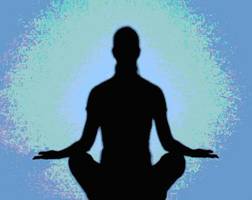
YOGA POSES FOR INFLUENZA
Lion Pose
Yoga Lion Pose is a great exercise for your face muscles and neck. It also heals sore throat symptom. In Sanskrit, Simha means a lion or power. The posture looks like a roaring lion.
Head Wrap Pose
Before you begin, wrap your forehead to relieve tension in the head. Take a wide ace bandage (about 4 inches) and wrap it snugly around the head, tucking the free end in. You can also wrap it over the eyes, taking care not to wrap the eyes too tightly. The bandage will comfort your congested sinuses.
Standing Forward Bend Pose
Standing Forward Bend is the second pose in Sun Salutation. This pose brings energy to the head and respiratory area; helps clear the sinuses.
Fish Pose
Fish Yoga Pose open the chest and throat which helps relieve upper respiratory congestion as well as benefits the heart. It is the counter pose to shoulder stand.
Shoulder Stand Pose
Shoulder Stand Pose stretches the neck muscles. This pose increases the blood supply to the upper part of the body especially head, neck and shoulder. It is a therapeutic for asthma and sinusitis.
Bow Pose
The Bow Pose is a good exercise to improve posture and strengthen the back muscles. This pose is so called because it looks like an archer's bow, the torso and legs representing the body of the bow, and the arms the string.
Boat Pose
This exercise strengthens the belly muscles, the legs and the lower back. It is also beneficial to those with kidney, thyroid, prostate and intestine problems. The Boat Pose is a great stress reliever and also improves digestion.
YOGA ASANAS FOR INFLUENZA
SARAVANGASANA
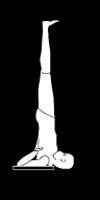
Yoga is one of the oldest form physical disciplines in existence. There are numerous types of asana that are performed in Yoga, one of them being Ardha Sarvangasana. It is the Queen of all the asans. Just as the name 'Sarvang' suggests 'all parts', the asan is essentially concerned with all the parts of the body.
Steps
• Lie flat on your back. Inhale deeply while raising your legs and spine until the toes point to the ceiling.
• Breathe slowly and deeply with the abdomen and concentrate on the thyroid gland. On a male, the thyroid gland is located behind the Adams apple. For women, it is located in the same area which is a few inches above the sternal notch (hollow of the neck where the neck joins the rest of the body.) or approximately half way up the neck from the sternal notch. Stay in this position for about two minutes.
• Release the hands, and either stretch the arms straight and rest the back of the hands on the knees or join the palms in front of the chest. Keep the back erect and stay I n the pose for about 30 seconds with deep breathing.
• To come out of this posture, just bend your knees, curve your back and slowly return to lying on the floor while exhaling. First bend your knees, put the palms on the floor, then curving the spine, gradually unfold it the way one unrolls a carpet. When your entire back touches the floor, straighten the knees, take a deep breath and slowly lower your legs to the ground while breathing out.
• If you wish, you may go straight into the next posture (the 'reverse posture') instead of lying down.
SHIRSHASANA
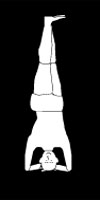
Sirsasana meaning headstand is considered to be one of the most important yoga poses. Sirsasana is known as "the queen of poses", and the reason relates to the effect it has on the brain and mind. The inversion of this pose causes increased and unrestricted blood flow to the brain. This brings increased oxygen, nutrient and vitality providing energy to the mind, clarity of thought and ease of concentration.
Steps
• Start by placing yourself opposite to a wall. Sitting on your legs, bend the elbows and place hands on opposite arms.
• Lean forward and place the elbows down perpendicular to the floor.
• Without moving the elbows open the lower arms into a triangular shape, creating an 80 degrees angle. Keep fingers interlocked.
• Place the crown of the back on the floor supported by the hands. Keep the hands on the back of the head.
• Straighten the knees and walk towards the body, raising the upper body.
• Lift the legs up balancing the legs on a wall to start with until you can balance your body up without falling onto your back. Bring feet away from the wall keeping the knees up straight. Breathing normally, concentrating on the breathing for balance.
• Keep the pressure away from the head supporting the body weight mainly with the forearms. Hold this posture for about 3 to 5 minutes to obtain maximum benefit. To come out drop the legs down gradually and rest in the child pose for at least 10 seconds.
PARYANKASANA
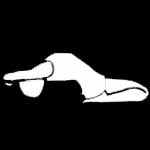
'Paryanka' refers to 'bed or cushion'. Though; this exercise resembles suptha veerasana, the benefits and the advantages are relatively high.Paryankasana gives a full stretch to the anterior and antero-internal muscles of the abdomen and the pelvic. The inner thighs as well get a good stretch.
Steps
• Start with Suptha Veerasana..
• Inhale slowly, raises the back and slowly lifts the neck and chest so that there is a perfect arch. No part of the trunk should be on the floor.
• Stretch and fold the arms; at the elbows. Place the folded arms on the floor behind the head. Hold in this posture for minute and breathe slowly.
• Exhale slowly, and then slowly place the trunk and neck on the floor and come back to Veerasana position.
SHAVASANA
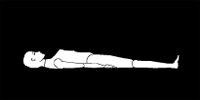
Shavasana is relaxation of body and mind in the position of lying on the back. This asana helps in relaxing mind and body and helps in restoring energy. It is a relaxing posture intended to rejuvenate one's body, mind and spirit. While shavasana is a good way to reduce stress and tension it is not recommended for meditation as it has a tendency to induce sleepiness.
Steps
• Lie on the back.
• Keep your spine, navel & pelvic in one line.
• Keep feet apart.
• Keep arms on the each side of body, palms facing to sky.
• Keep neck right or left side.
• Close your eyes & slowly try to concentrate each part of the body & try to relax that part.
• Breath normally.
ANULOMVILOMPRANAYAM
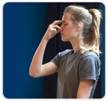
Anulom Vilom Pranayam is also known as Nadi Shodhana Pranayama or alternate nostril breathing. By the practice of this asana the whole nervous system is cleansed and toned.
Steps
• One should sit comfortably in padmasana or sukhasana, keeping back straight and breathing normally. Form the pranayam posture with right hand.
• Close your right nostril with your right thumb and exhale slowly through the left nostril.
• Allow your back to come close to the ground and lie supine.
• Now inhale, slowly to your maximum capacity and then close left nostril with your ring and little finger and lift the thumb off the right nostril and exhale slowly through the right nostril.
• Then again inhale slowly through the right nostril and close it with thumb and lift your ring and little finger from left nostril and exhale slowly.
MATSYASANA
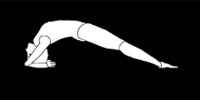
Matsya in Sanskrit means fish. One immediately identifies this asana with the figurative relevance like any other hatha asanas. But here the asana is suggestive of the quality of floating like a fish - a state that's induced by assuming this posture.MatsyasanaTraditional texts state that Matsyasana is the "destroyer of all diseases." This asana is therapeutically helpful in constipation, respiratory faculties, fatigue and anxiety. It's also good for preventing mildly recurring backaches before they go worse.
Steps
• Assume padmasana If it is difficult, assume a comparable posture (Swasthikasana or Sukhasana).
• Bend backwards and touch the ground with the back of your head while not changing the position of your legs.
• Use hands to give support to body so that your body doesn't fall flat. While you lay backwards while keeping the legs as in padmasana, your body assumes the same of a fish, with the legs forming the tailfins. The back, shoulders, neck, most part of head and parts below knee will not touch the ground.
• Now extend your hands and grasp your big toes. Right hand grasps left big toe, which is on the left side of the body.
• Breathe slowly while in Matsyasana pose.
• Take hands backwards and place them on the ground as a support. Slowly raise your head and come to Padmasana pose.
ASTROLOGY
Astrology has never been as popular as it is today. This is because more and more people are realizing the possibilities that Astrology can offer. Astrology can provide you with a deeper insight into your career path, your relationships, your home life, your relationship with money and the world at large. Its scope is broad because it is a symbolic reflection of life itself. According to astrological reports for yoga asanas the above mentioned asanas are said to be effective for those who come under the following zodiac sign.
• PISCES